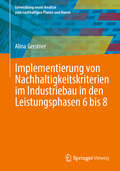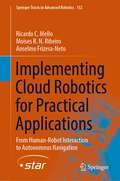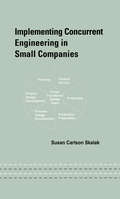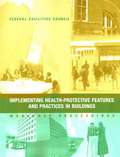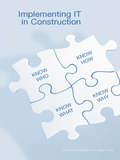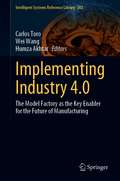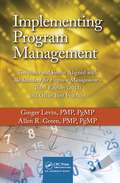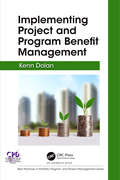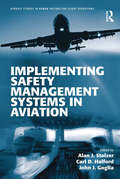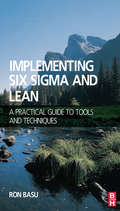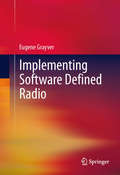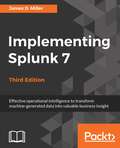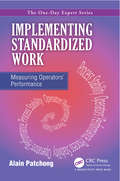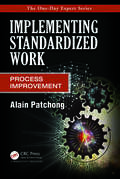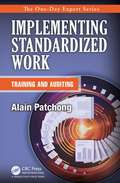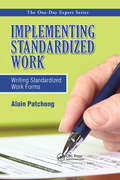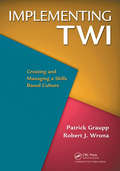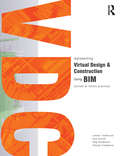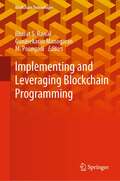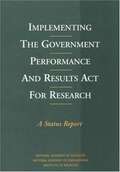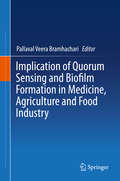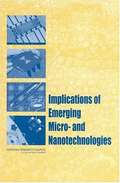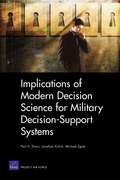- Table View
- List View
Implementierung von Nachhaltigkeitskriterien im Industriebau in den Leistungsphasen 6 bis 8 (Entwicklung neuer Ansätze zum nachhaltigen Planen und Bauen)
by Alina GerstnerDie Bauindustrie trägt wesentlich zu einer nicht nachhaltigen Lebensweise bei, da sie unter anderem signifikant hohe CO₂-Emissionen, einen großen Flächen- und Ressourcenverbrauch sowie erhebliche Abfallmengen verursacht. Um nationale als auch globale Nachhaltigkeitsziele zu erreichen und eine lebenswerte Umwelt zu sichern, muss die Bauwirtschaft Verantwortung übernehmen und Bauvorhaben zielstrebig nachhaltiger planen und umsetzen. In diesem Buch wird ein Leitfaden zur Implementierung von Nachhaltigkeitskriterien speziell für Industriebauten entwickelt, der in der Objektplanung Anwendung finden soll. Der Fokus liegt dabei auf den Leistungsphasen 6 bis 8 der HOAI, da diese Phasen – welche die Ausschreibung, Vergabe und Bauausführung umfassen – als besonders relevant für die Sicherstellung einer nachhaltigen Bauweise gelten. Sie können als Schlüsselphasen betrachtet werden, in denen geplante Nachhaltigkeitsziele konkret überführt, konkretisiert sowie anschließend in der Praxis umgesetzt werden müssen. Der Leitfaden soll die Objektplanung dabei unterstützen, konkrete Ziele und Maßnahmen vorzugeben, um die Realisierung eines nachhaltigen Industriebaus zu gewährleisten. Dabei werden relevante Regelwerke, Zertifizierungs- und Bewertungssysteme sowie wissenschaftliche Arbeiten und bestehende Leitfäden detailliert untersucht. Neben den Zielsetzungen und den entsprechenden Maßnahmen jeder Leistungsphase fließen auch verschiedene Nachhaltigkeitsdimensionen wie Ökologie, Ökonomie und Soziales in die Bewertung ein, um damit eine ganzheitliche und umfassende Betrachtung der Nachhaltigkeitsaspekte zu gewährleisten. Weiterhin sollen zur Förderung einer flexiblen Gestaltung auch spezifische Projektanforderungen, wie z.B. Vorgaben der EU-Taxonomie, Zertifizierungsindikatoren oder die individuellen Wünsche des Bauherrn berücksichtigt werden. Abschließend wird der Leitfaden in einem Referenzprojekt angewendet und evaluiert, um die Praxistauglichkeit zu überprüfen und Möglichkeiten für dessen Optimierung bei zukünftigen Industriebauprojekten zu identifizieren.
Implementing Cloud Robotics for Practical Applications: From Human-Robot Interaction to Autonomous Navigation (Springer Tracts in Advanced Robotics #152)
by Ricardo C. Mello Moises R. Ribeiro Anselmo Frizera-NetoThis book explores cloud robotics by casting a light on key issues and proposing a novel approach towards implementation and practical aspects to allow for the widespread adoption of cloud-based functionality. The advent of cloud robotics can to unleash a new generation of smart robotic devices by allowing robots to explore cloud computing capabilities to share data and to offload heavy processing applications. Cloud robotics is investigated as an enabler to a series of applications and devices, questioning how the insertion of network and cloud technologies into such systems might affect the interaction between a robot and the human operating it, and what are the limiting requirements for cloud-based solutions. Aiming at researchers and practitioners, this book also presents a methodology based on open-source software and commercial off-the-shelf devices to provide a common standard for reproducing and benchmarking different cloud robotics systems.
Implementing Concurrent Engineering in Small Companies
by Susan SkalakPresenting a systematic approach to concurrent engineering (CE), this reference accommodates the small corporation's quest to incorporate better design management practices. The author provides an easy-to-follow methodology that eliminates the need for costly consultants, promotes environmentally friendly solutions, and introduces three main design models to aid in new, evolutionary, and incremental product design. She also examines how the adoption of CE practices improves overall performance. Topics include engineering specifications for product parameters, conceptual and embodiment design, vendor selection and approval, prototyping, and line and equipment installation.
Implementing Energy Efficiency in Industries
by G C RoyThis book focuses on designing, implementing, and verifying the performance of energy efficiency and conservation (EE&C) projects in relevant industries from a practitioner’s perspective. Various techniques and approaches are presented using case studies collated from the author’s notes from about four decades of working in process industries and two decades as an international sustainable energy consultant.Features: Provides a broad overview of the main issues in implementing energy efficiency in industries. Focuses on implementation issues – technical, financial and employee engagement. Provides a brief description on the fundamental thermodynamic principles that drive efficiency and conservation. Includes a comparative evaluation of ESCO performance contract implementation. Charts out the energy efficiency journey, developing long-term goals and short-term activities. Includes case studies related to energy efficiency in energy-intensive large industries. This book is aimed at professionals working in energy engineering, industry, efficiency, and policy.
Implementing Health-protective Features And Practices In Buildings: Workshop Proceedings
by National Research Council of the National AcademiesThe National Academies Press (NAP)--publisher for the National Academies--publishes more than 200 books a year offering the most authoritative views, definitive information, and groundbreaking recommendations on a wide range of topics in science, engineering, and health. Our books are unique in that they are authored by the nation's leading experts in every scientific field.
Implementing IT in Construction
by James Sommerville Nigel CraigContrary to stereotype, the construction industry has embraced IT with some vigour. Computers are used effectively across the sector and this use is increasing. A range of new issues have emerged in consequence. This practical book draws on direct industrial experience and examines the role of IT within a range of enterprises operating in the construction and property industry. Emphasis is given to the human side of IT and the effects of the implementation of IT systems on them. The functionality of the IT systems is considered, as is the design brief and the operation of the applications. Case reviews of a range of applications are discussed and issues arising from their implementation are explored. Pitfalls, benefits and experience shapers are reviewed and presented systematically so the reader can consider these in the light of their own experience. Outlining key drivers for advanced students and for professionals who may have to face these issues in the future, Implementing IT in Construction clearly presents the value of IT implementation and the benefits of a number of IT applications.
Implementing Industry 4.0: The Model Factory as the Key Enabler for the Future of Manufacturing (Intelligent Systems Reference Library #202)
by Wei Wang Carlos Toro Humza AkhtarThis book relates research being implemented in three main research areas: secure connectivity and intelligent systems, real-time analytics and manufacturing knowledge and virtual manufacturing. Manufacturing SMEs and MNCs want to see how Industry 4.0 is implemented. On the other hand, groundbreaking research on this topic is constantly growing. For the aforesaid reason, the Singapore Agency for Science, Technology and Research (A*STAR), has created the model factory initiative. In the model factory, manufacturers, technology providers and the broader industry can (i) learn how I4.0 technologies are implemented on real-world manufacturing use-cases, (ii) test process improvements enabled by such technologies at the model factory facility, without disrupting their own operations, (iii) co-develop technology solutions and (iv) support the adoption of solutions at their everyday industrial operation. The book constitutes a clear base ground not only for inspiration of researchers, but also for companies who will want to adopt smart manufacturing approaches coming from Industry 4.0 in their pathway to digitization.
Implementing Program Management: Templates and Forms Aligned with the Standard for Program Management, Third Edition (2013) and Other Best Practices (Best Practices And Advances In Program Management Ser. #6)
by Ginger Levin Allen R. GreenSuccess in program management requires discipline, complete plans, well-run meetings, accurate record keeping, and adherence to global best practices. Implementing Program Management: Templates and Forms Aligned with the Standard for Program Management, Third Edition (2013) and Other Best Practices provides the templates and guidelines for the plan
Implementing Project and Program Benefit Management (Best Practices in Portfolio, Program, and Project Management)
by Kenn DolanOne of the most difficult, yet important, questions regarding projects is "What advantages will this project create for the investors and key stakeholders?" Projects and programs should be treated as investments. This means that the focus of projects shifts from delivering within the triple constraints (time–cost–quality) towards some of the more fundamental questions: <P><P> <li>What is the purpose of this investment? <li>What are the specific advantages expected? <li>Are these benefits worth the investment? <P><P>Implementing Project and Program Benefit Management is written for executives and practitioners within the portfolio, program, and project environment. It guides them through the important work that must be addressed as the investment progresses towards the realization of benefits. The processes discussed cover the strategic elements of benefits realization as well as the more detailed requirements, which are the domain of the program delivery teams and the operational users. Using real cases to explain complex situations, operational teams and wider groups of stakeholders, including communities affected by infrastructure projects, will be able to engage in the conversation with the sponsors and delivery teams. <P><P>Covering an area of program and project management that is rapidly becoming more widely valued, this book blends theory with practical experience to present a clear process flow to managing the benefits life cycle. Best practices are defined, and pitfalls and traps are identified to enable practitioners to apply rigor and structure to this crucial discipline.
Implementing Safety Management Systems in Aviation (Ashgate Studies in Human Factors for Flight Operations)
by Alan J. Stolzer John J. Goglia Carl D. HalfordThe International Civil Aviation Organization has mandated that all of its member states implement Safety Management Systems (SMS) in their aviation industries. Responding to that call, many countries are now in various stages of SMS development, implementation, and rulemaking. In their first book, Safety Management Systems in Aviation, Stolzer, Halford, and Goglia provided a strong theoretical framework for SMS, along with a brief discourse on SMS implementation. This follow-up book provides a very brief overview of SMS and offers significant guidance and best practices on implementing SMS programs. Very specific guidance is provided by industry experts from government, industry, academia, and consulting, who share their invaluable insights from first-hand experience of all aspects of effective SMS programs. The contributing authors come from all facets of aviation, including regulation and oversight, airline, general aviation, military, airport, maintenance, and industrial safety. Chapters address important topics such as how to develop a system description and perform task analyses, perspectives on data sharing, strategies for gaining management support, establishing a safety culture, approaches to auditing, integrating emergency planning and SMS, and more. Also included is a fictional narrative/story that can be used as a case study on SMS implementation. Implementing Safety Management Systems in Aviation is written for safety professionals and students alike.
Implementing Six Sigma and Lean
by Ron BasuThis is a comprehensive, user-friendly and hands-on book that is a single source of reference of tools and techniques for all quality practitioners. Implementing Six Sigma and Lean covers the basics of how to manage for consistently high quality and gives good coverage of both simple tools and advanced techniques which can be used in all businesses. This book provides guidance on how to use these tools for different situations such as new start-up companies, stalled projects and the constant achievement of high quality in well-established quality regimes.Case studies are included that encourage the reader to respond in a practical situations and provide a good learning resource for courses. There are summaries of key elements and questions with exercises at the end of each chapter.
Implementing Software Defined Radio
by Eugene GrayverSoftware Defined Radio makes wireless communications easier, more efficient, and more reliable. This book bridges the gap between academic research and practical implementation. When beginning a project, practicing engineers, technical managers, and graduate students can save countless hours by considering the concepts presented in these pages. The author covers the myriad options and trade-offs available when selecting an appropriate hardware architecture. As demonstrated here, the choice between hardware- and software-centric architecture can mean the difference between meeting an aggressive schedule and bogging down in endless design iterations. Because of the author's experience overseeing dozens of failed and successful developments, he is able to present many real-life examples. Some of the key concepts covered are: Choosing the right architecture for the market - laboratory, military, or commercial, Hardware platforms - FPGAs, GPPs, specialized and hybrid devices, Standardization efforts to ensure interoperability and portabilitym State-of-the-art components for radio frequency, mixed-signal, and baseband processing. The text requires only minimal knowledge of wireless communications; whenever possible, qualitative arguments are used instead of equations. An appendix provides a quick overview of wireless communications and introduces most of the concepts the readers will need to take advantage of the material. An essential introduction to SDR, this book is sure to be an invaluable addition to any technical bookshelf.
Implementing Splunk 7, Third Edition: Effective Operational Intelligence To Transform Machine-generated Data Into Valuable Business Insight, 3rd Edition
by James D. MillerThis book will help you implement Splunk 7's new services and will show you how to utilize them to quickly and efficiently process machine-generated big data. You will explore Splunk Cloud and the Machine Learning Toolkit and use them with ease throughout your organization. By the end of the book, you will have learned to implement these services in your tasks at work.
Implementing Standardized Work: Measuring Operators Performance
by Alain PatchongThis book, the first in The One-Day Expert series dedicated to Standardized Work, is about operator performance measurement. Implementing Standardized Work: Measuring Operators Performance explains how to measure the performance of operators quickly and simply without sacrificing accuracy.Detailing how to identify the most efficient operators and
Implementing Standardized Work: Process Improvement
by Alain PatchongThis book, the third in a series dedicated to Standardized Work, focuses on process improvement. Implementing Standardized Work: Process Improvement begins by explaining why standardization and process improvement are two sides of the same coin both needing each other to achieve true sustainability.Describing how to use Standardized Work forms to i
Implementing Standardized Work: Training and Auditing
by Alain PatchongStandardized Work refers to the process of finding and applying the best operational methods that will lead to cost reduction, better product quality, and increased operator safety. This book, the latest in a series dedicated to Standardized Work, focuses on operator training and auditing. It describes the methods and tools used to train operators
Implementing Standardized Work: Writing Standardized Work Forms
by Alain PatchongThe first book in The One-Day Expert series detailed the initial steps that Thomas, a young, high-potential plant manager in an industrial group, took to assess his plant‘s situation through measurement of operators performance. The second book in the series, Implementing Standardized Work: Writing Standardized Work Forms focuses on the next step
Implementing TWI: Creating and Managing a Skills-Based Culture
by Patrick Graupp Robert J. WronaFeaturing strategies employed in Lean, this volume describes the experiences of organizations using TWI more than 60 years after the Training Within Industry program turned the U.S. into the industrial giant that won World War II. Based on their experience implementing TWI in organizations as diverse as Virginia Mason Medical Center and Donnelly Ma
Implementing Virtual Design and Construction using BIM: Current and future practices
by Lennart Andersson Kyla Farrell Oleg Moshkovich Cheryle CranbourneImplementing Virtual Design and Construction using BIM outlines the team structure, software and production ecosystem needed for an effective Virtual Design and Construction (VDC) process through current real world case studies of projects both in development and under construction. It provides the reader with a better understanding of the successful implementation of VDC and Building Information Modeling (BIM), and the benefits to the project team throughout the design and construction process. For readers already familiar with VDC, the book will provide invaluable examples of best practices and real world solutions. Richly illustrated in color with actual VDC documentation, visualizations, and statistics, the reader is shown the real processes undertaken and outputs generated when working on high profile building information models. Online animations, interviews with practitioners, and downloadable templates, forms and files make this an interactive and highly engaging way to learn a crucial set of skills. While keeping up with current industry practice is a minimum requirement, this book goes further by helping you prepare for the next level of virtual design and construction. This is essential reading for project managers, construction managers, architects, design managers, and anybody with a role in BIM or virtual construction.
Implementing and Leveraging Blockchain Programming (Blockchain Technologies)
by Bharat S. Rawal Gunasekaran Manogaran M. PoongodiThis book gives a comprehensive overview of blockchain programming and its implementation in the wide range of blockchain-based applications such as cross-border payment, digital banking, and digital identities. The consistent thrive of the blockchain phenomenon and the ecosystem of e-business use cases have led to the Industrial Revolution in the e-business world, and it is demonstrated in this book. The digital advancement, interference, and transformation being brought through the influence of the blockchain advancements are creating waves across e-business verticals. The book caters to academics, industrial practitioners, and entrepreneurs working in the field of blockchain technology and programming.
Implementing the Government Performance and Results Act for Research: A Status Report
by Institute of MedicineAs requested by Congress and the White House Office of Science and Technology Policy (OSTP), this report assists federal agencies in crafting plans and reports that are responsive to the Government Performance and Results Act (GPRA), OMB Guidance, and agency missions. Using a case study approach, the report identifies best practices used by individual agencies to evaluate the performance and results of their science and technology programs. The report takes into account individual agencies' missions and how science and technology programs and human resource needs are factored into agency GPRA plans. Specific applications of recommendations are included from COSEPUP's earlier report entitled Evaluating Federal Research Programs: Research and the Government Performance and Results Act.
Implication of Quorum Sensing and Biofilm Formation in Medicine, Agriculture and Food Industry
by Pallaval Veera BramhachariThe book illustrates the role of quorum sensing in the food industry, agriculture, veterinary sciences, and medicine. It highlights the importance of quorum sensing in regulating diverse cellular functions in microbes, including virulence, pathogenesis, controlled-gene expression systems, and antibiotic resistance. This book also describes the role of quorum sensing in survival behavior and antibiotic resistance in bacteria. Further, it reviews the major role played by quorum sensing in food spoilage, biofilm formation, and food-related pathogenesis. It also explores the methods for the detection and quantification of quorum sensing signals. It also presents antimicrobial and anti-quorum sensing activities of medicinal plants. Finally, the book elucidates a comprehensive yet representative description of basic and applied aspects of quorum sensing inhibitors. This book serves an ideal guide for researchers to understand the implications of quorum sensing in the food industry, medicine, and agriculture.
Implications Of Nanotechnology For Environmental Health Research
by Institute of Medicine of the National AcademiesThe National Academies Press (NAP)--publisher for the National Academies--publishes more than 200 books a year offering the most authoritative views, definitive information, and groundbreaking recommendations on a wide range of topics in science, engineering, and health. Our books are unique in that they are authored by the nation's leading experts in every scientific field.
Implications of Emerging Micro- and Nanotechnologies
by Committee on Implications of Emerging Micro- NanotechnologiesExpansion of micro-technology applications and rapid advances in nano-science have generated considerable interest by the Air Force in how these developments will affect the nature of warfare and how it could exploit these trends. The report notes four principal themes emerging from the current technological trends: increased information capability, miniaturization, new materials, and increased functionality. Recommendations about Air Force roles in micro- and nanotechnology research are presented including those areas in which the Air Force should take the lead. The report also provides a number of technical and policy findings and recommendations that are critical for effective development of the Air Force's micro- and nano-science and technology program.
Implications of Modern Decision Science for Military Decision-Support Systems
by Paul K. Davis Jonathan Kulick Michael EgnerA selective review of modern decision science and implications for decision-support systems. The study suggests ways to synthesize lessons from research on heuristics and biases with those from "naturalistic research." It also discusses modern tools, such as increasingly realistic simulations, multiresolution modeling, and exploratory analysis, which can assist decisionmakers in choosing strategies that are flexible, adaptive, and robust.
